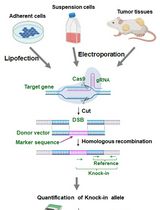- EN - English
- CN - 中文
Optogenetic Targeting of Mouse Vagal Afferents Using an Organ-specific, Scalable, Wireless Optoelectronic Device
使用器官特异性、可扩展的无线光电设备对小鼠迷走神经传入进行光遗传学靶向研究
发布: 2022年03月05日第12卷第5期 DOI: 10.21769/BioProtoc.4341 浏览次数: 2652
评审: Zinan ZhouNarayan SubramanianDhiman Sankar Pal
Abstract
Optogenetics has the potential to transform the study of the peripheral nervous system (PNS), but the complex anatomy of the PNS poses unique challenges for the focused delivery of light to specific tissues. This protocol describes the fabrication of a wireless telemetry system for studying peripheral sensory pathways. Unlike existing wireless approaches, the low-power wireless telemetry offers organ specificity via a sandwiched pre-curved tether, and enables high-throughput analysis of behavioral experiments with a channel isolation strategy. We describe the technical procedures for the construction of these devices, the wireless power transmission (TX) system with antenna coils, and their implementation for in vivo experimental applications. In total, the timeline of the procedure, including device fabrication, implantation, and preparation to begin in vivo experimentation can be completed in ~2-4 weeks. Implementation of these devices allows for chronic (>1 month) wireless optogenetic manipulation of peripheral neural pathways in freely behaving animals navigating homecage environments (up to 8).
Keywords: Wireless optogenetics (无线光遗传学)Background
Optogenetics has transformed neuroscience by enabling the targeted manipulation of genetically defined neural cell types (Deisseroth, 2011 and 2015). This typically involves expressing a light-activated ion channel using a Cre driver mouse and implanting an optical fiber in the brain (Park et al., 2015b, 2015a and 2016). In this way, it is possible to activate or inactivate specific cell types with light and thereby test their causal role in behavior (Kim et al., 2013; Montgomery et al., 2015; Shin et al., 2017).
Optogenetics also has the potential to transform the study of the PNS, but the complex anatomy of the PNS poses unique challenges for the focused delivery of light to specific tissues (Towne et al., 2013; Montgomery et al., 2016; Maimon et al., 2018). The PNS consists of sensory and motor neurons, with cell bodies located in widely distributed peripheral ganglia. The major sensory ganglia include dorsal root ganglia, which consist of clusters of cell bodies of spinal sensory neurons that are organized bilaterally along the length of the spine, and nodose ganglia, which contain the cell bodies of vagal sensory neurons (Berthoud and Neuhuber, 2000).
These two sensory systems broadly innervate a range of peripheral organs that differ in their size, shape, location, and accessibility, necessitating individualized strategies for light delivery to different tissues (Berthoud, 2008; de Lartigue, 2016; Williams et al., 2016). Moreover, some of these organs are highly mobile during normal physiology or behavior (e.g., movement of the intestine during digestion), which further complicates the positioning and anchoring of optical fibers. Thus, unlike in the brain, it is a considerable challenge to develop robust strategies for the delivery of light selectively to peripheral tissues in freely behaving animals.
In principle, it is possible to target peripheral tissues with light using a wired fiber optic that stimulates the animal via the back or rectum (Caggiano et al., 2016; Hibberd et al., 2018), analogous to the intracranial fiber optics commonly used in the brain. While this approach has the advantage that it can be readily coupled with off-the-shelf components (e.g., lasers and LEDs), the abdominal viscera differs from the brain, in that it lacks a stable interface for securing large fiber optics and preventing motion. Moreover, the inflexible nature of most optical fibers can cause the shearing of tissues and nerves, or of the fiber itself, during normal animal movement. For this reason, wired fiber optics have been used less frequently for peripheral optogenetics in behaving animals (Maimon et al., 2017 and 2018; Towne et al., 2013).
An alternative approach is to implant a wireless probe that internalizes the light source, thereby bypassing physical constraints associated with fiber optic cables. Strategies for such wireless, radio-frequency(RF)-powered devices have recently been described (Montgomery et al., 2015 and 2016; Park et al., 2015a and 2015b), but it remains a major challenge to achieve long-term, organ-restricted illumination, without impeding normal behavior or physiology. For example, a wirelessly powered micro-light emitting diode (µLED) has been secured to the rat bladder using a circumferential elastomer sleeve (Mickle et al., 2019), but this device impedes normal organ expansion. A wireless flexible device that sutures a µLED onto the heart surface has been reported (Gutruf et al., 2019), but it has not been demonstrated to function for more than eight days, precluding most behavioral studies. More generally, affixing any µLED to a target organ surface results in light back-scatter and non-specific optogenetic illumination of nearby tissues.
Recently, we developed and published a new class of implantable wireless devices, demonstrating their applicability to study the vagus nerve (Kim et al., 2021). This new wireless optogenetic implant delivers light to nerve endings from inside the stomach, via a pre-curved tether. This intragastric light delivery enables illumination of stomach innervating nerves, with much greater specificity than µLEDs affixed to the organ surface, and could in principle be extended to study other organs, such as the intestine. Here, we describe the technical procedures for the fabrication of these devices and their in vivo applications.
Materials and Reagents
Pipet tips (VWR, catalog number: 613-0239)
Glass slide (Brain Research Laboratories, catalog numbers: 5075 and 3040)
Copper/Polyimide (Cu/PI) film (DupontTM Pyralux®, catalog number: AC181200RY)
Wescorp anti-static high-temp Polyimide tape (Desco, catalog number: 81270)
Photoresistor (AZ®, catalog number: AZ1518)
Cored wire for soldering (Multicore, catalog number: 397952)
Electrical components [Supplementary Figure 1 from previous work (Kim et al., 2021)]
Gauze (Medique, catalog number: 60673)
6-0 Silk suture (Braintree Scientific, catalog number: NC9201232)
3-0 PGA sutures (Pro Advantage, catalog number: P420493)
5-0 PGA suture (Stoelting, catalog number: 50495)
4-0 Nylon sutures (Pro Advantage, catalog number: P420661)
Betadine (Fisher Scientific, catalog number: 19-027132)
70% Isopropyl Alcohol (Fisher, catalog number: 19-027026)
2-propanol (Fisher Chemical, catalog number: 190971)
Methyl Alcohol, Anhydrous (Macron, catalog number: 3016-16)
Acetone (Macron, catalog number: 2440-16)
Developer solution (AZ®, AZ Developer 1:1)
Copper etchant (Alfa AesarTM, catalog number: Z03E099)
Flux no-clean lead-free (Chip Quik, Inc., catalog number: SMD291NL)
Polydimethylsiloxane (PDMS) (Dow®, SylgardTM 184 Silicone Elastomer Kit)
DAPI Fluoromount-G (SouthernBiotech, catalog number: 0100-20)
Ketoprofen (Sigma, catalog number: K2012-5G)
Isoflurane (Piramal NDC 66794-017-10)
Material cleaning (see Recipes)
Electrical sample cleaning (see Recipes)
Photoresistor spin coating (see Recipes)
UV-lithography and wet-etching (see Recipes)
PDMS preparation (see Recipes)
Equipment
Scissors (Fine Science Tools, catalog number: 14090-09)
Magnetic retractors (Fine Science Tools, catalog number: 18200-20)
Spatula (Fine Science Tools, catalog number: 10091-12)
Graefe knife (Fine Science Tools, catalog number: 10059)
Graefe forceps (Fine Science Tools, catalog number: 11153-10)
Bonn artery scissors, ball tip (Fine Science Tools, catalog number: 14086-09)
Ring forceps (Fine Science Tools, catalog number: 11103-09)
32G needle (Hamilton, 75SN syringe, catalog number: 87908)
Fine-tipped Dumont forceps (Fine Science Tools, catalog number: 11251-20)
Flat-tipped forceps (Fine Science Tools, catalog number: 11220-21)
Dumont forcep (Fine Science Tools, Dumont #5SF Forceps)
Sterile disposable scalpels (TruMed©, 190618)
Spin-coat (SCS, G3P-8)
Isotemp stirring hotplate (Fisher Scientific, SP88850200)
UV lithography (EV Group, EVG610)
Stereo microscope (AVEN, SPZT 50)
Soldering machine (Weller, WD1002/WP80)
Milligram balance (Intelligent Weighing Technology, PM-300)
Vacuum pump (Across International, EasyVac-9)
Vacuum oven (Across International, Accu Temp 1.9)
Oven (Quincy La, Inc., Model 30 Lab Oven)
RF generator (FEIG Electronic, ID ISC.LRM2500-A)
Dynamic antenna tuner, matching board (FEIG Electronic, ID ISC.DAT)
Nanoject II Auto-Nanoliter Injector (Drummond Scientific Company, 3-000-204)
Laser-scanning confocal microscope (Olympus, FV1200)
Epifluorescent microscope (Nikon, Eclipse E600)
Software
ISO Start2017 v9.9.10 (FEIG Electronic GmbH)
BioDAQ Viewer v. 2.2.01 (Research Diets)
Procedure
文章信息
版权信息
© 2022 The Authors; exclusive licensee Bio-protocol LLC.
如何引用
Hong, S., Kim, W. S., Han, Y., Cherukuri, R., Jung, H., Campos, C., Wu, Q. and Park, S. I. (2022). Optogenetic Targeting of Mouse Vagal Afferents Using an Organ-specific, Scalable, Wireless Optoelectronic Device. Bio-protocol 12(5): e4341. DOI: 10.21769/BioProtoc.4341.
分类
神经科学 > 周围神经系统
神经科学 > 基础技术 > 光遗传学
您对这篇实验方法有问题吗?
在此处发布您的问题,我们将邀请本文作者来回答。同时,我们会将您的问题发布到Bio-protocol Exchange,以便寻求社区成员的帮助。
提问指南
+ 问题描述
写下详细的问题描述,包括所有有助于他人回答您问题的信息(例如实验过程、条件和相关图像等)。
Share
Bluesky
X
Copy link












